INSTRUCTIONS TO STUDENTS
- Answer ALL the questions in section A and B in the spaces provided after each question.
- All working must be clearly shown.
- Mathematical tables and electronic calculators may be used.
- All numerical answers should be expressed in decimal notations.
- Take the charge of an electron e= 1.6x10-19 C

QUESTIONS
SECTION A (25 MARKS)
- A white paper is a good reflector of light but does not form an image like a mirror. Explain this observation. (1mark)
- State and explain the observation made when an uncharged metal sphere is brought close to a negatively charged electroscope. (2marks)
-
- When is a lead acid accumulator said to be fully charged? (1mark)
- A form one student at Daima High School connected a simple electric circuit as shown in the figure below.
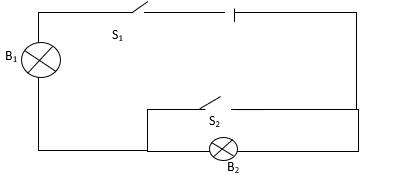
State and explain the observation made when switches S1 and S2 are both closed (2marks)
- A magnetic material was heated and then cooled in a magnetic field. After cooling, it was found to be magnetized. Explain this using domain theory. (2 marks)
- The diagram in figure below shows a narrow beam of white light incident on to a glass prism.

- Complete the diagram to show dispersion of white light. (1 mark)
- Explain the observation made on the screen. (1 mark)
- The potential difference across a lamp is 12V and a charge of 10C passes through it. Determine the electrical energy changed to heat and light by the lamp. (2 marks)
- The figure below shows a connection to a three-pin plug.

- Identify the cable labelled X in the plug. (1 mark)
- State the use of the component labelled Y in the plug. (1 mark)
- Give one reason why the earth pin is normally longer than the other pins. mark)
- The table below shows the arrangement of electromagnetic waves in the order of increasing energy of radiation.

State one use of the wave marked C (1 mark) - The figure below shows point source of light with an opaque object placed between it and a screen.

Explain the nature of the shadow formed along AB. (2 marks) - The figure below shows the cross-section of a conductor held between two bar magnets and a current carrying conductor in the direction shown.

- Indicate with an arrow on the diagram the direction in which the conductor will move when it is released. (1 mark)
- State one adjustment that can be made on the diagram to increase the magnitude of the force on the conductor carrying current. (1 mark)
- The figure below shows a block diagram of a P–N junction diode. On the same diagram, show how a cell may be connected so that it is reverse biased. (1 mark)

- An observer standing d metres from the foot of a high wall claps her hands once and an echo reaches her after 0.5 seconds. If the velocity of sound in air is 330m/s, determine the value of d. (2 marks)
- Complete the ray diagram below to illustrate how a concave mirror can be used as a shaving mirror. (2 marks)

SECTION B (55 MARKS)
-
- In an experiment to observe interference of light waves, a double slit is placed close to the source.

- State the function of the double slit. (1 mark)
- State and explain what is observed on the screen. (2 marks)
- State what is observed on the screen when;
- the slit separation S1S2 is reduced. (1 mark)
- white light source is used in place of monochromatic source. (1 mark)
- State and explain the difference in the patterns observed on the screen other than the difference in colour when the source of red light is replaced by a source of violet light. (2 marks)
- In a Young’s slit experiment using sodium light, seven fringe spaces were found to occupy 2.8mm when viewed through a microscope eye piece. Calculate the fringe separation. (1 mark)
- A real image, half the size of the object is formed by a lens. If the distance between the object and the image is 45cm, determine the focal length of the lens. (3 marks)
- In an experiment to observe interference of light waves, a double slit is placed close to the source.
-
-
- State Lenz’s law. (1 mark)
- A power station generators 10kV at current of 5A. The voltage is stepped up to 200kV before being transmitted through cables. Assuming the transformer is 80% efficient. Determine the output power in the secondary coil. (2 marks)
- State with reason which coils are thicker in the step up transformer (2 marks)
- The diagram below shows a simple alternating generator ( a.c )rotating in clockwise direction just passing horizontal position.
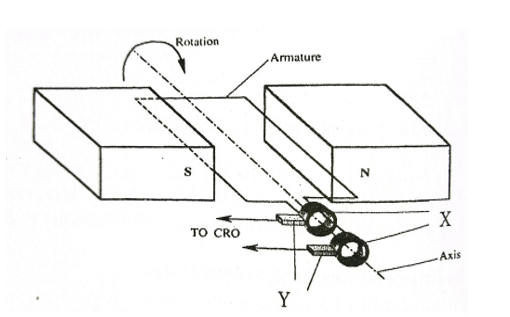
- Name the parts labelled X and Y (2 marks)
X _____________________________________________
Y______________________________________________ - State the function of feature labelled Y. (1 mark)
- On the same diagram show the direction of the induced current in the rectangular coil. (1 mark)
- State two ways in which the induced e.m.f. in the coil be increased. (2 marks)
- On the axes below sketch the variation of induced e.m.f,E0, against angle of inclination ∅ of the coil for one revolution starting from vertical position. (2 marks)
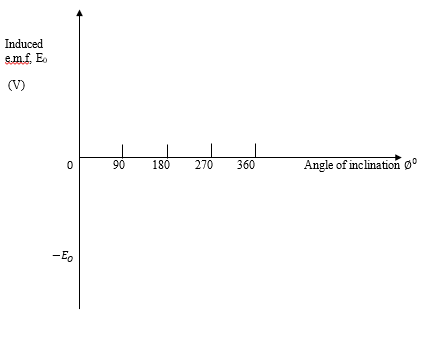
- Name the parts labelled X and Y (2 marks)
-
-
- The diagram below shows cathode rays going through a magnetic field. complete the diagram to show the path followed by the cathode rays. (1 Mark)

- The time base setting of a CRO is set at 5ms/division while the y-gain is at 50 v/divisions. In the grid provided, sketch the graph of an a.c signal with a peak voltage of 200V and frequency 50HZ. (show at least one cycle)
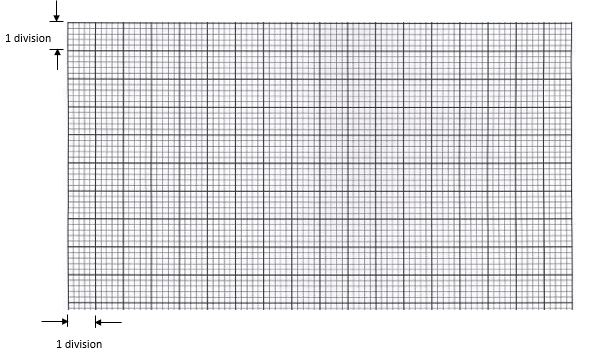
-
- State ohms law.
- Figure below shows a simple electric circuit used to investigate the relationship between the internal resistance r of a cell and the electromotive force, E, of the cell
.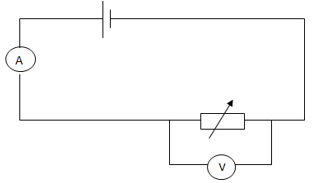
- Show that the terminal voltage of the cell is given by; (2 marks)
V= E- Ir - Several values of current and voltage were collected and the graph was drawn as shown below.
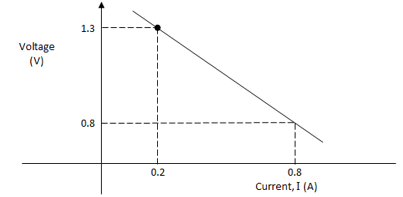
Use the graph to calculate the internal resistance of the cell. (3 marks)
- Show that the terminal voltage of the cell is given by; (2 marks)
- The diagram below shows cathode rays going through a magnetic field. complete the diagram to show the path followed by the cathode rays. (1 Mark)
- The diagram shows a picture of a machine that produces X-rays. Use it to answer the questions that follow
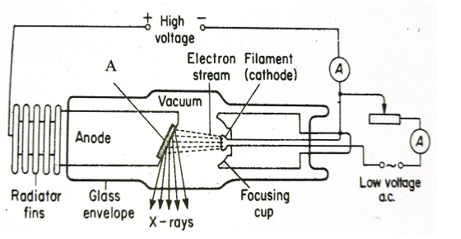
- Explain how the X-rays are produced (2marks)
-
- The machine is almost entirely surrounded by a metal shield. Name this metal and explain why this metal must surround it. (2marks)
- State the reason why the cathode is concave shaped (1mark)
- Explain the function of the radiator fins in facilitating the cooling of the anode target (1 mark)
-
- State the adjustment that should be made in order to produce X-rays of higher strength. (1mark)
- The tube operates at 50KVand the tube current is 20mA. Calculate the number of electrons hitting the target per second (2marks)
-
- The diagram below shows one of the detectors of radiation.

- Identify the device. (1 mark)
- Name the parts labelled A and B. (2 marks)
A -
B - - Explain how radiation entering the mica window is detected. (2 marks)
- A small amount of halogen vapour is usually present in the tube. What is its purpose (1 mark)
- The set up below shows UV light striking a zinc plate placed on uncharged electroscope.
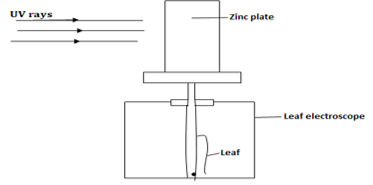
- State and explain the observations made. (2 mark)
- In an experiment using a photocell, U.V light of varying frequency but constant intensity was made to strike a metal surface. The maximum kinetic energy (KEMax) of photoelectrons for each frequency, f, was measured. The graph shows how KEMax varies with f.
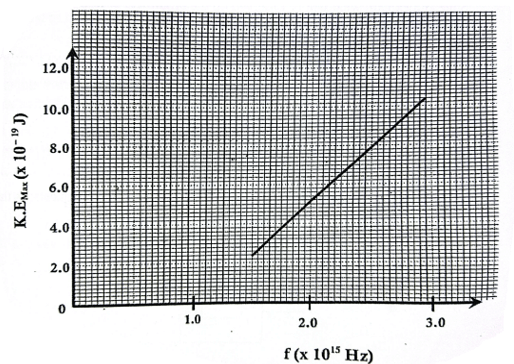
Given that K.EMax = h f - Ø, determine the values:- Constant, h (2 marks)
- Constan ,Ø (2 marks)
- The diagram below shows one of the detectors of radiation.

MARKING SCHEME
SECTION A (25 MARKS)
- A white paper is a good reflector of light but does not form an image like a mirror. Explain this observation. (1mark)
- White paper is rough, parallel inadent rays are reflected are irregular. Mirror is smooth and inadent parallel rays are reflected regulary y mirror
- State and explain the observation made when an uncharged metal sphere is brought close to a negatively charged electroscope. (2marks)
- The leaf falls/collapses/divergence decreases
- positive charge is induced on the neutral meal sphere. this causes attraction of elecrons from the metal plate and leaf to the cap hence the leaf falls
-
- When is a lead acid accumulator said to be fully charged? (1mark)
- when gassing out occurs( when oxygen and hydrogen gases begin to gas out)
- A form one student at Daima High School connected a simple electric circuit as shown in the figure below.

State and explain the observation made when switches S1 and S2 are both closed (2marks)- B1 lights while b2 does not
- current flows through B1 since i is in a closed circuit while B2 does not light since it is short circuit
- When is a lead acid accumulator said to be fully charged? (1mark)
- A magnetic material was heated and then cooled in a magnetic field. After cooling, it was found to be magnetized. Explain this using domain theory. (2 marks)
- The dipoles vibrate due to heating, on cooling they setle in the earth's direction of magnetic acid
- The diagram in figure below shows a narrow beam of white light incident on to a glass prism.

- Complete the diagram to show dispersion of white light. (1 mark)
- Explain the observation made on the screen. (1 mark)
- While light has differen colors of differen wavelengths, hence they travel with different velocity when they enter glass red is refracted least since it has higher velocity then velocity is deviated most.
- The potential difference across a lamp is 12V and a charge of 10C passes through it. Determine the electrical energy changed to heat and light by the lamp. (2 marks)
- =(D C X lav;
120J
- =(D C X lav;
- The figure below shows a connection to a three-pin plug.

- Identify the cable labelled X in the plug. (1 mark)
- Neutral lead/cable
- State the use of the component labelled Y in the plug. (1 mark)
- Fuse safeguards against excess current in a circuit
- Give one reason why the earth pin is normally longer than the other pins. mark)
- Longer since i is the first one to enter hence opens the socket by pushing the shutter/blind for the other fuse pins to enter
- Identify the cable labelled X in the plug. (1 mark)
- The table below shows the arrangement of electromagnetic waves in the order of increasing energy of radiation.

State one use of the wave marked C (1 mark)- infra red photography
- drying grains
- green houses
- heat seeking missiles
- The figure below shows point source of light with an opaque object placed between it and a screen.

Explain the nature of the shadow formed along AB. (2 marks)- Completely or dark shadow (umbra); become light is completely obsracted by opaque object
- The figure below shows the cross-section of a conductor held between two bar magnets and a current carrying conductor in the direction shown.

- Indicate with an arrow on the diagram the direction in which the conductor will move when it is released. (1 mark)
- State one adjustment that can be made on the diagram to increase the magnitude of the force on the conductor carrying current. (1 mark)
- increase size of curren in the conductor
- uses stronger magnets
- increases length of conductor in magnetic field
- The figure below shows a block diagram of a P–N junction diode. On the same diagram, show how a cell may be connected so that it is reverse biased. (1 mark)

- An observer standing d metres from the foot of a high wall claps her hands once and an echo reaches her after 0.5 seconds. If the velocity of sound in air is 330m/s, determine the value of d. (2 marks)
- V=2d/t
330=2(d)/0.5
d=330*0.5/2
=82.5m
- V=2d/t
- Complete the ray diagram below to illustrate how a concave mirror can be used as a shaving mirror. (2 marks)

SECTION B (55 MARKS)
-
- In an experiment to observe interference of light waves, a double slit is placed close to the source.

- State the function of the double slit. (1 mark)
- Act as coherent sources of light
- State and explain what is observed on the screen. (2 marks)
- Alternate bright and dark fringes are seen on the screen
- Bright fringes formed due to constructive interference dark fringe are formed due to destructive interference
- State what is observed on the screen when;
- the slit separation S1S2 is reduced. (1 mark)
- Fringe seperation become widely spaced
- white light source is used in place of monochromatic source. (1 mark)
- central light fringe is white; all the light fringes are coloured(spectrum)
- State and explain the difference in the patterns observed on the screen other than the difference in colour when the source of red light is replaced by a source of violet light. (2 marks)
- In a Young’s slit experiment using sodium light, seven fringe spaces were found to occupy 2.8mm when viewed through a microscope eye piece. Calculate the fringe separation. (1 mark)
- the slit separation S1S2 is reduced. (1 mark)
- State the function of the double slit. (1 mark)
- A real image, half the size of the object is formed by a lens. If the distance between the object and the image is 45cm, determine the focal length of the lens. (3 marks)
m=1/2=V/u
u=2V
u+V=45
2v+v=45
u=15cm
v=30cm
f=uv/u+v
=15*30/15+30
=450/45
=10cm
- In an experiment to observe interference of light waves, a double slit is placed close to the source.
-
-
- State Lenz’s law. (1 mark)
- The direction og induced e.m.f is such that the induced current causes the flow produses a magnetic effect that exposes the charge producing it
- A power station generators 10kV at current of 5A. The voltage is stepped up to 200kV before being transmitted through cables. Assuming the transformer is 80% efficient. Determine the output power in the secondary coil. (2 marks)
- power input = IpVp = 5*10,000 = 50 000w
power output = 80/100 * 50000 = 40 000w
- power input = IpVp = 5*10,000 = 50 000w
- State with reason which coils are thicker in the step up transformer (2 marks)
- State Lenz’s law. (1 mark)
- The diagram below shows a simple alternating generator ( a.c )rotating in clockwise direction just passing horizontal position.

- Name the parts labelled X and Y (2 marks)
X slip ring
Y carbon brush - State the function of feature labelled Y. (1 mark)
- conducts current and as a lubricant since it is slippery
- On the same diagram show the direction of the induced current in the rectangular coil. (1 mark)
- State two ways in which the induced e.m.f. in the coil be increased. (2 marks)
- increase speed of rotation
- increase the strength of magnetic field
- On the axes below sketch the variation of induced e.m.f,E0, against angle of inclination ∅ of the coil for one revolution starting from vertical position. (2 marks)
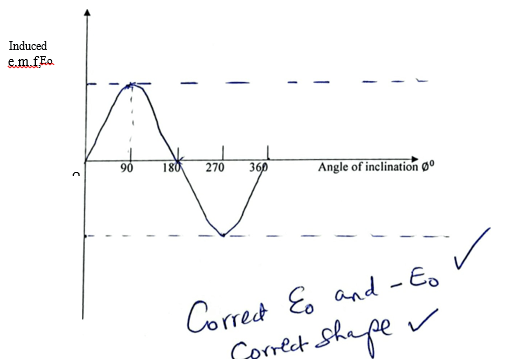
- Name the parts labelled X and Y (2 marks)
-
-
- The diagram below shows cathode rays going through a magnetic field. complete the diagram to show the path followed by the cathode rays. (1 Mark)

- The time base setting of a CRO is set at 5ms/division while the y-gain is at 50 v/divisions. In the grid provided, sketch the graph of an a.c signal with a peak voltage of 200V and frequency 50HZ. (show at least one cycle)

y=200/50=4dw
20ms=x*5ms/dw
x=4cm -
- State ohms law.
- The amount of current flowing through a conductor is directly propotional to the p.d across is end provided temperature and other physical conditions are kept constant
- Figure below shows a simple electric circuit used to investigate the relationship between the internal resistance r of a cell and the electromotive force, E, of the cell
.
- Show that the terminal voltage of the cell is given by; (2 marks)
V= E- Ir- E=I(R+r)
E=IR+lr
E=V+lr ; v=E-lr
- E=I(R+r)
- Several values of current and voltage were collected and the graph was drawn as shown below.

Use the graph to calculate the internal resistance of the cell. (3 marks)
- slope
-(0.8-1.3/0.8-0.2)V/A
-(-0.8333)
=0.8233Ω
- slope
- Show that the terminal voltage of the cell is given by; (2 marks)
- State ohms law.
- The diagram below shows cathode rays going through a magnetic field. complete the diagram to show the path followed by the cathode rays. (1 Mark)
- The diagram shows a picture of a machine that produces X-rays. Use it to answer the questions that follow

- Explain how the X-rays are produced (2marks)
- The hot filament heats up the cathode to high temperature and produces electrons by thermionic emission e- are accelerated at high potential to the anode and hit it. the K.e of the e- is converted to x-rays e heat
-
- The machine is almost entirely surrounded by a metal shield. Name this metal and explain why this metal must surround it. (2marks)
- lead; to absord x-rays produced at unsuitable angles
- State the reason why the cathode is concave shaped (1mark)
- to focus the electrons onto the argets
- Explain the function of the radiator fins in facilitating the cooling of the anode target (1 mark)
- increase the effective area for conduction of heat from the target
- The machine is almost entirely surrounded by a metal shield. Name this metal and explain why this metal must surround it. (2marks)
-
- State the adjustment that should be made in order to produce X-rays of higher strength. (1mark)
- increase the acceleration p.d between anode and cathode that will increase the speed of electrons
- The tube operates at 50KVand the tube current is 20mA. Calculate the number of electrons hitting the target per second (2marks)
- Q=ie=ne
n=it/e
n=20*10-3*1/1.6*10-19
=n=1.25*1017e
- Q=ie=ne
- State the adjustment that should be made in order to produce X-rays of higher strength. (1mark)
- Explain how the X-rays are produced (2marks)
-
- The diagram below shows one of the detectors of radiation.

- Identify the device. (1 mark)
- G>M tube
- Name the parts labelled A and B. (2 marks)
A - cathode/metal cylinder/aluminium
B -Anode - Explain how radiation entering the mica window is detected. (2 marks)
- radiation enters mica window and ionise argon, the negative ions drift to the anode while positive ions move to cathode resulting in pulse currents across R
- A small amount of halogen vapour is usually present in the tube. What is its purpose (1 mark)
- As a quenching agent/ it absorbs the k.e of the positive ions before they hit the cathode
- Identify the device. (1 mark)
- The set up below shows UV light striking a zinc plate placed on uncharged electroscope.

- State and explain the observations made. (2 mark)
- leaf rises; uv liberates electrons and as they escape, a net positive charge is left on the leaf and the plate causing leaf to rise
- In an experiment using a photocell, U.V light of varying frequency but constant intensity was made to strike a metal surface. The maximum kinetic energy (KEMax) of photoelectrons for each frequency, f, was measured. The graph shows how KEMax varies with f.

Given that K.EMax = h f - Ø, determine the values:- Constant, h (2 marks)
- h=slope
(10.2-0)*10-19/
(2.9-1.05)*1015
h=5.514*10-34Js
- h=slope
- Constan ,Ø (2 marks)
- Ø = wo=hfo
=5.51*10-34*1.05*1015
=5.7897*10-19J
- Ø = wo=hfo
- Constant, h (2 marks)
- State and explain the observations made. (2 mark)
- The diagram below shows one of the detectors of radiation.
Join our whatsapp group for latest updates
Tap Here to Download for 50/-
Get on WhatsApp for 50/-
Download Physics Paper 2 Questions and Answers - Kassu Jet Joint Mock Exams 2023.
Tap Here to Download for 50/-
Get on WhatsApp for 50/-
Why download?
- ✔ To read offline at any time.
- ✔ To Print at your convenience
- ✔ Share Easily with Friends / Students
